By Timothy Kast
Photos By Shannon Yokeley
This exceptional bayonet is currently in use by special units of the Italian Army; most notably the ‘Nibbio’ contingent in Afghanistan. They much preferred carrying Extrema Ratio’s ‘Fulcrum’ fixed blades as their primary issue knife. From there, they pressed Extrema Ratio to develop the same knife into an issue bayonet to reduce weight and excess gear. Extrema Ratio responded by creating a bayonet/knife/tool system that became even more versatile by the addition of a wire cutter as well as the availability of a mine probe tool.
The bayonet has always been associated with military long guns and has often been illustrated in field manuals and considered part of the necessary kit for the fighting firearm. This example is designed for the AR-15/M16/M4 family of weapons. The first thing you will notice upon inspection of this unit is the precision fit of the bayonet to the rifle. There is no excess of movement or waggle when the rifle is maneuvered with zeal.
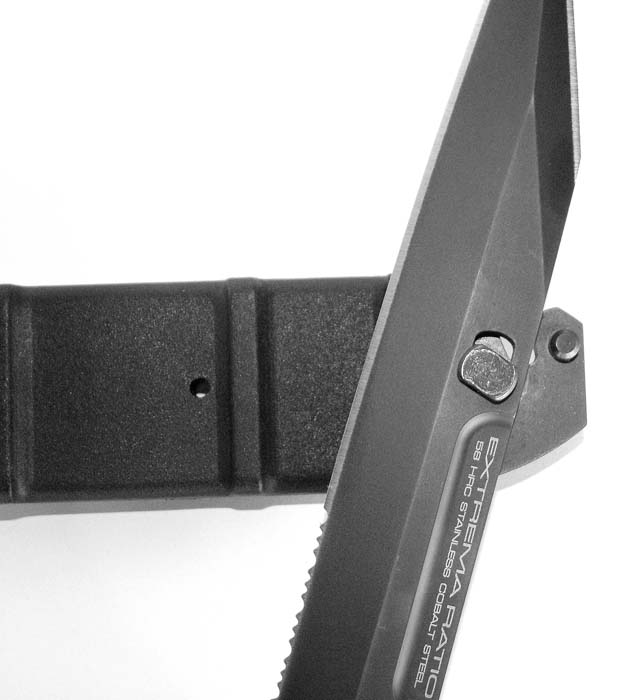
The overall package, i.e. knife in sheath, is designed to make a slim modular profile in accordance with the current demand that manufacturers account for every ounce in order to make each individual soldier’s combat load lighter and more maneuverable. Most bayonets are of a nominal size, about the span of a common hunting knife; however this is a magnum knife with an overall length of 12.2 inches (310mm). The obvious need for extensive design work was evident, so that the whole package melded with the cadre to become part of the complete trooper. Extrema Ratio has rivaled one of the most revered of bayonets – the legendary Eickhorn model, standard equipment of the fabled Cadillac Gage Stoner 63A – to become one of the most capable issue bayonets of the new millennium.
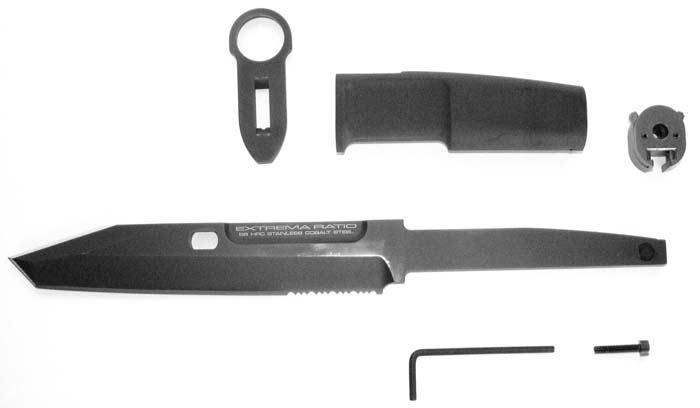
Cut from a .25 inch (6.3mm) thick slab of N690 Stainless Cobalt Steel hardened to 58 HRC, the 7.09 inch (180mm) long blade is capped with a milled pommel fashioned from AISI 316L Stainless Steel that supplies the aft mount for the M4 carbine. The front mount is machined from AISI 316L Stainless Steel flat stock and also serves as a front hand-guard to protect the hand from sliding forward onto the cutting edge of the blade, were the hand to become slippery. The removable-for-cleaning fiberglass reinforced Forprene handle insulates flesh from electrical shock if you happen to employ the wire-cutter feature on an electrified defense. The accompanying polimeric sheath also works with the Forprene to insulate the hands while working. The design of the Forprene handle addresses the ergonomics of adaptability to the human hand under stressful conditions to index the cutting edge to the operator, so that in low light to dark, the cadre always is aware of exactly where the cutting edge is.
The cutting surfaces of the knife blade are uniquely multifaceted to supply exceptionally sharp edges to the top, the leading edge, the bottom straight edge, as well as a section, toward the choil, of a serrated edge for cutting rope or line. This makes for a truly versatile tool. A bayonet aids in many other tasks such as preparation of foodstuffs and cutting up kindling for a fire. The main straight edge is capable of a plethora of slicing and dicing chores. This leaves the front edges to cut cleaning patches for your weapon or to press into service as a combat knife. Remember that this bayonet pattern was originally taken from Extrema Ratio’s flagship design, the Fulcrum, and is an extremely capable combat tactical knife in its own right.
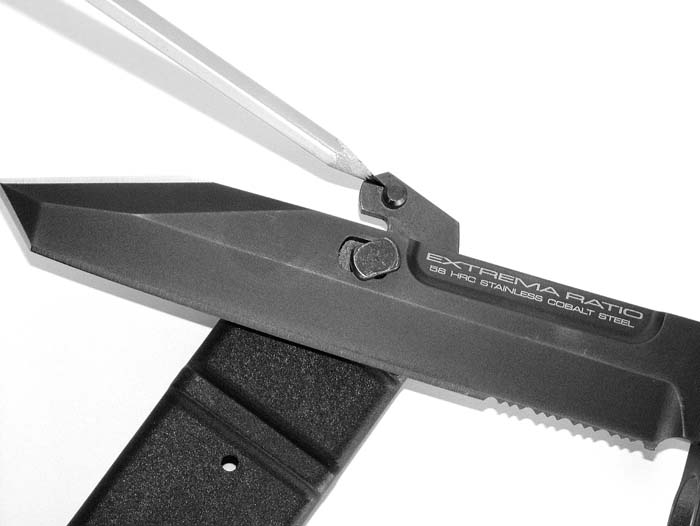
Extrema Ratio has made an additional relief cut on the spine of the knife to reduce overall weight without sacrificing lateral strength and also to bring the point of balance to a neutral position preferred by most knife makers: the hilt or hand-guard. Inside of this relief resides the Extrema Ratio Marquee and the type of steel (N690 Cobalt Stainless) used in the manufacture of the bayonet.
All of the metal surfaces are impregnated with a non-reflective flat black wear-resistant finish to reduce the chance of corrosion afield. The entire bayonet can be disassembled for cleaning and maintenance. The Forprene handle can slide off of the blade itself should the operator desire to fashion an improvised spear for fishing or hunting duties. This it does admirably with just the correct amount of heft and a sharp edge for a quick, efficient kill. An Allen wrench is hidden in the Velcro sheath webbing to assist in the disassembly/reassembly of the bayonet.
Extrema Ratio was one of the very first knife manufacturers to use N690 Stainless Cobalt Steel for their blade steel. This steel has proven to be exceptional in durability, flexibility and toughness. It is comprised of Carbon (1.07%), Chrome (17.00%), Cobalt (1.50%), Manganese (0.40%), Molybdenum (1.10%), Silicium (0.40%), and Vanadium (0.10%). N690 is martensistic special steel that differs from AISI 440C in that it carries double the amount of molybdenum. The use of molybdenum is significant because it bears improved cutting features and adds a strong resistance to corrosion. For this superior steel, Extrema Ratio purchases only from a small, specialized manufacturer in Austria known for their uncompromising quality. Overall, N690 features high resistance to corrosion and wear, maintains a sharp cutting edge longer, and polishes to a brilliant degree. It can also reach a higher hardness level through thermic tempering that eclipses 440C considerably. Thanks to oxidation resistance and its ability to hold an edge, it is often preferred by the medical industry for surgical tools and by the food industry for food preparation.
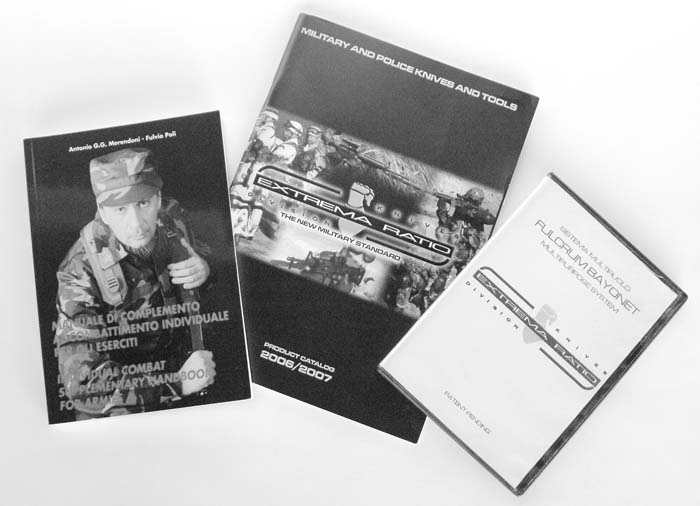
One of the most fascinating aspects of the Prato, Italy-based manufacturer is the amount of research and product development that goes into every knife or tool that leaves this maker. Working closely with the Faculty of Motorial Sciences of the University of Perugia, they were able to explore the ergonomics of these tools and how they relate to the end users. They also maintain a close relationship with the Faculty of Engineering at the University of Florence where they conduct structural, materials and coating analyses. They were even able to determine side load strength that revealed this Fulcrum style bayonet could survive loads of over 150 kg without breaking. The cadre of the ‘Nibbio’ contingent use their bayonets aggressively, often driving them into rock crevasses in Afghanistan to employ them as makeshift steps so that they might successfully scale the mountain. Every facet of these knives have been tested far beyond the normal rigors, hence the firm’s name Extrema Ratio, meaning literally Extreme Measures. Founded in 1997, they are certified ISO 9001, as well as being part of the Armed Forces supplier’s listings: NATO CODE (N/Cage): A D 856.
The bayonet is admirably coupled with its rigid ABS composite plastic sheath to form an improvised barbed wire cutter that is capable of defeating all but the largest of fence wire. The bayonet locks securely onto the corresponding lug on the sheath and the movement of the cutter is smooth, tight and unhampered. Many cutters formed on some of the European-Asian bayonets have sufficient slop in their anvils that it becomes obviously pointless to continue trying to gnaw your way through the wire. Not so with the Extrema Ratio, where the close progression of the cutter through its arc severs neatly the fence wire in one fluid stroke without hesitation or wobble. This is essential in a tool of this description that everything works with flawless precision. Sending a ripple down through stretched fencing while you haphazardly chew at the wire with an inferior tool could lead to an untimely demise.
The ABS sheath fits down into a Cordura pouch and harness assembly that attaches the knife and sheath to elastic leg straps that ensures that the bayonet system is jump-qualified. The lug straps hug the bayonet closely to the thigh without any undue movement or travel. The pouch part of the harness protects the barb wire cutter anvil so that it doesn’t become a snag at an inopportune moment. Four snaps secure the bayonet and sheath into the harness with an easy access strap at the top. This system is secure without being bulky as it has all been skeletonized to streamline the operator’s basic working equipment load.
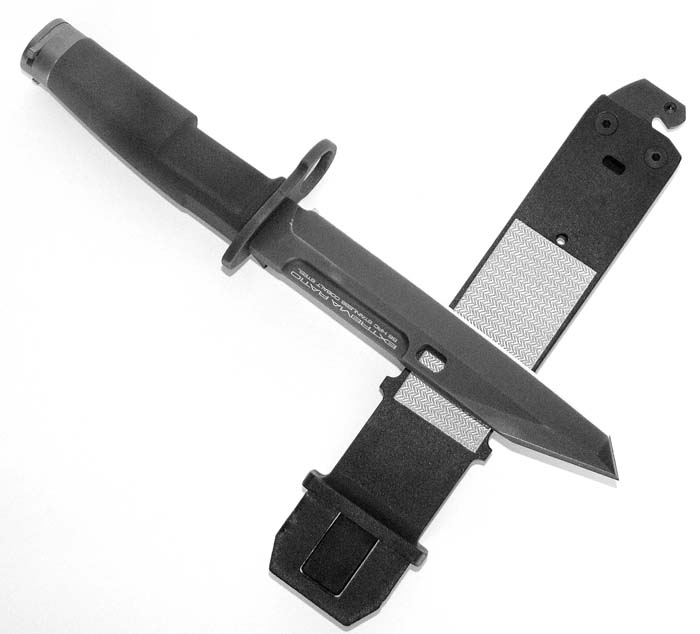
Bayonets have quite a lore about them and, as many things that are made for the military, they are available in a variety of finishes: white for snowy terrain, green for woodland, tan for sandy terra and even gold plating for parade dress. The vibrant color schemes are carried out through to the leg straps for a more thorough and complete set of terrain specific gear. The cadre are the most important; the better the gear adapts the operator to the terrain he or she is working in, the better the soldier will be protected to complete the mission. Modern day equipment has come full circle. 60s-70s technology was to produce a basic quality piece of gear like the Eickhorn Stoner 63A bayonet and then the operator adapted to the bayonet, i.e., performed with its strengths and ignored, overlooked and compensated for its weaknesses or lack of detail. The Extrema Ratio Fulcrum bayonet is representative of today’s latest interpretation of modern day equipment. It was developed as to have virtually zero defects. It relates to the operator and is truly is an exceptional piece of gear.
While the example depicted here is fitted for the AR-15/M16/M4 family of weapons, Extrema Ratio has proven that their bayonet is truly international with fitment on request for the Beretta SC/SCP, Heckler & Koch G3 and G36, FAMAS, Steyr AUG, FN FAL, SIG 550 and the Kalashnikov AK series.
Extrema Ratio s.S.S.
Via Turcoing, 40/P
59110 Prato (PO) Italy
Telephone: 39-0574-584639
Fax: 39-0574-561312
www.extremaratio.com
| This article first appeared in Small Arms Review V12N3 (December 2008) |











